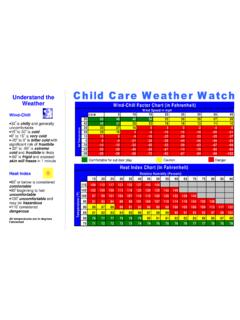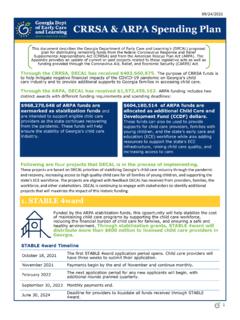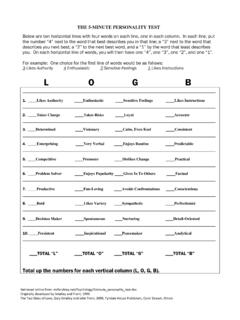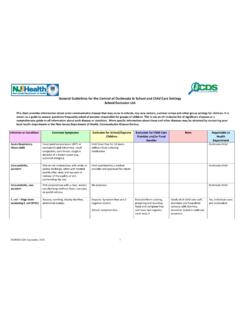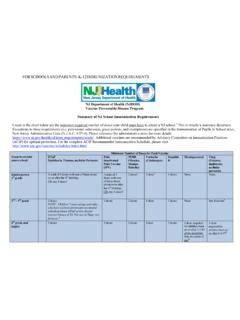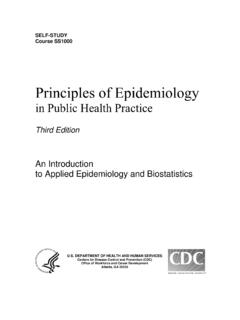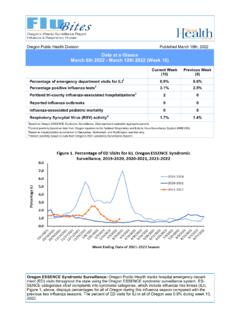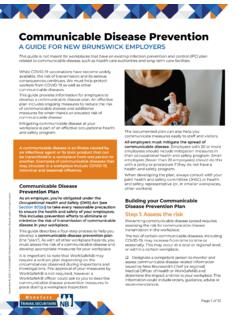Transcription of Communicable Disease Chart
1 Disease , illness or organismIncubation period (How long after contact does illness develop?)How is it spread?When is a child most contagious?When can a child return to the childcare center or school?Report to county health department*How to prevent spreading infection (management of conditions)**Eye, ear, nose, throat and chestTo prevent the spread of organisms associated with common infections, practice frequent hand hygiene, cover mouth and nose when coughing and sneezing, and stay up to date with , bronchitis, common cold, croup, ear infection, pneumonia, sinus infection and most sore throats (respiratory diseases caused by many different viruses and occasionally bacteria)VariableContact with droplets from nose, eyes or mouth of infected person; some viruses can live on surfaces (toys, tissues, doorknobs) for several hoursVariable, often from the day before symptoms begin to 5 days after onsetNo restriction unless child has fever, or is too uncomfortable, fatigued or ill to participate in activities (center unable to accommodate child s increased need for comfort and rest)NOCold sore (Herpes simplex virus)2 days to 2 weeksDirect contact with infected lesions or oral secretions (drooling, kissing, thumb sucking)While lesions are presentWhen active lesions are no longer present in children who do not have control of oral secretions (drooling); no exclusions for other childrenNOAvoid kissing and sharing drinks or (Pink eye)Variable, usually 24 to 72 hoursHighly contagious.
2 Contact with secretions from eyes of an infected person or contaminated surfacesDuring course of active infectionOnce treatment beginsNODiphtheria (Corynebacterium diphtheriae bacteria)1 to 10 days (usually 2 to 5 days)Contact with droplets and discharge from eyes, nose, throat or skin of infected person; rarely, transmission may occur from skin lesions or articles soiled with discharges from lesions of infected personWithout antibiotic therapy, usually less than 2 weeks, but occasionally as long as 6 months. A child is no longer infectious after treatment with appropriate antibioticsAfter 2 negative cultures are taken at least 24 hours apartYEST imely immunization beginning at 2 months old; booster dose of Tdap is recommended at 11 years old; all adults should receive a booster of Tdap. Close contacts, regardless of immunization status, should be monitored for 7 days for evidence of Disease and started on antimicrobial prophylaxis; immunizations should be brought up to date, if (the flu) (influenza virus)1 to 4 daysHighly contagious; contact with droplets from nose, eyes or mouth of infected person; virus can live on surfaces (toys, tissues, doorknobs) for several hoursVariable; from 24 hours before onset of symptoms to 7 days after onset; can be prolonged in young childrenNo fever for 24 hours without the use of fever-reducing medicinesNO for individual cases; YES for influenza-associated deaths or novel influenza A virus infectionsAnnual influenza vaccine recommended for everyone 6 months and older (with rare exception).
3 Mononucleosis (Mono) (Epstein-Barr virus)30 to 50 daysContact with the infected person s salivaIndeterminateNo restriction unless child has fever or is too uncomfortable, fatigued or ill to participate in activities (center unable to accommodate child s increased need for comfort and rest)NOAvoid kissing and sharing drinks or (mumps virus)12 to 25 days (usually 16 to 18 days)Contact with saliva or mucus from the mouth, nose or throat of an infected person1 to 2 days before symptoms appear through 5 days after onset5 days after onset of parotid gland (neck) swellingYESA void sharing beverage containers, eating utensils and kissing. Timely immunization beginning at 12 months old. Vaccination of contacts may be syncytial virus (RSV)2 to 8 days (4 to 6 days is most common)Highly contagious; contact with droplets from nose, eyes or mouth of infected person; virus can live on surfaces (toys, tissues, doorknobs) for several hoursVariable; from the day before onset of symptoms until 3 to 8 days after or longer; may last up to 3 to 4 weeksNo fever for 24 hours without the use of fever-reducing medicinesNOPractice meticulous hand hygiene and avoid contact with respiratory throat (Group A Streptococcus bacteria)2 to 5 daysContact with droplets from nose and mouth; close, crowded contactHighest during acute infection.
4 No longer contagious within 24 hours after antibioticsAfter 24 hours of antibiotic treatmentNOAvoid close contact with symptomatic persons until completion of 24 hours of antimicrobial (TB) (mycobacterium tuberculosis)2 to 10 weeks (risk of developing Disease is highest 6 months to 2 years after infection)Airborne inhalation of droplets from nose and mouth of diseased person (children usually contract TB from close contact with a diseased adult)Usually only a few days to a week after effective drug therapy. Children younger than 10 years are rarely contagiousFor active Disease , once determined to be non-infectious, therapy started, symptoms diminished and adherence documented; no exclusion for latent infectionYESRisk-based screening of children may be indicated. Consult with local health department. Adults should undergo annual symptom and exposure screening with testing based on local risk cough (pertussis) (bordetella pertussis bacteria)4 to 21 days (usually 7 to 10 days)Contact with droplets from nose, eyes or mouth of infected person1 to 2 weeks before cough onset to completion of 5 days of appropriate antibiotic.
5 If untreated, infectious for 3 weeks after cough onsetAfter 5 days of appropriate antibiotic treatment; if untreated, 3 weeks after onset of coughYEST imely immunization beginning at 2 months old; booster dose of Tdap is recommended at 11 years old. All adults should receive a booster dose of Tdap. Close contacts that are unimmunized should have pertussis immunization initiated. Chemoprophylaxis is recommended for all close prevent spreading infection for all GI diseases, avoid potentially contaminated beverages, food and water, and divide food preparation and diapering responsibilities among staff. Gastroenteritis bacterial (vomiting and/or diarrhea) Campylobacter, C. difficile (Clostridium difficile), Shiga toxin-producing E. coli (Escherichia coli) or E. coli O157, Salmonella, ShigellaVaries with pathogen (from 10 hours to 7 days)Contact with stool from infected individual (or occasionally pets); contaminated food, beverages or water (especially raw eggs and improperly cooked meats)When diarrhea is present; pathogenic E.
6 Coli and Shigella are highly infectious in small doses even after diarrhea resolvesShiga toxin-producing E. coli, E. coli O157 and Shigella require 2 negative stool cultures; Salmonella serotypes Typhi and Paratyphi require 3 negative stool cultures; all others: no fever, diarrhea or vomiting for 24 hoursYES for E. coli, Salmonella, Campylobacter and Shigella; NO for othersFrequent, good handwashing, particularly by infected child and any caregivers assisting with toileting. Alcohol-based hand hygiene products do not inactivate C. difficile spores; soap and water must be used. Frequent cleaning of common-touch surfaces with appropriate cleaning agents (bleach is effective against C. difficile). Proper cooking and handling of meats and raw eggs. Reptiles and live poultry ( , chickens) should not be permitted in childcare viral (vomiting and/or diarrhea), Norovirus, Sapovirus, AdenovirusVaries with pathogen (from 12 hours to 10 days)Contact with stool, saliva or vomit from infected individual directly or from infected surfaces, especially toys; contaminated food or water; norovirus is highly contagious and is a frequent cause of outbreaksVariable; most contagious from 2 days before illness until vomiting and diarrhea improve; can be contagious for up to 21 days after symptomsNo fever, vomiting or diarrhea for 24 hoursNO for a single illness; YES for multiple illnesses or outbreakFrequent, good hand-washing, particularly by infected child and any caregivers assisting with toileting.
7 Alcohol-based hand hygiene products do not inactivate Norovirus; soap and water must be used. Frequent cleaning of common-touch surfaces with appropriate cleaning agents (bleach is effective against Norovirus at certain concentrations). Exclude ill children and staff until vomiting, diarrhea and fever-free for at least 24 (parasite)1 to 3 weeksContact with infected stool; animals, including dogs or cats; swallowing water from lakes, rivers or streams; or foodWhen diarrhea is presentNo fever, vomiting or diarrhea for 24 hoursYESGood hand hygiene, especially after playing outside, gardening or picking up pet feces. Avoid swallowing untreated water. Clean with bleach solution or quaternary ammonium compound A (virus)15 to 50 days (average 28 days)Eating contaminated food or water; close contact with infected individuals; contact with infected stoolFrom 1 to 2 weeks before illness until 1 week after onset of illness or after jaundice appears; can be longer in newborn infantsAfter 1 week from onset of illness or appearance of jaundiceYEST imely immunization at 12 months old; consider hepatitis A vaccine for caregivers; infected caregivers should not prepare meals for others.
8 If at least one case is confirmed, hepatitis A vaccine or immunoglobulin should be administered within 14 days of exposure to unimmunized (enterobius vermicularis)1 to 2 months or longerPinworms lay microscopic eggs near rectum, causing itching; infection spreads through ingestion of pinworm eggs after contamination of hands by scratchingEggs may survive up to 2 weeks after appropriate therapy and resolution of rectal itching; reinfection is commonNo restriction, but treatment should be given to reduce spreadNOFrequent, good hand-washing, particularly by infected child and any caregivers assisting with toileting; keep fingernails clean and short; prevent fingers in mouth; bed linen and underclothing of infected children should be handled carefully, not shaken and laundered to 3 daysContact with stool from infected individual; ingestion of contaminated water or food and contact with contaminated surfaces or objectsVirus is present in stools of infected children several days before the onset of diarrhea to several days after onset of diarrheaNo diarrhea presentNOTimely immunization beginning at 2 months prevent spreading infection for all meningitis diseases, practice frequent hand hygiene, properly dispose of soiled tissues, cover coughs and sneezes, and avoid sharing drinks and influenzae Type B (hib bacteria)Unknown (usually 1 to 10 days)Contact with droplets from nose, eyes or mouth of infected personUntil at least 24 hours of antibiotic treatment, including antibiotics to eliminate carrier stateAfter at least 24 hours of antibiotic treatment, including antibiotics to eliminate carrier state; child well enough to participateYEST imely immunization beginning at 2 months old.
9 Consult public health regarding vaccination and/or treatment of close meningitidis (meningococcal bacteria)1 to 10 days (usually less than 4 days)Contact with droplets from nose, eyes or mouth of infected personUntil at least 24 hours of antibiotic treatment, including antibiotics to eliminate carrier stateAfter at least 24 hours of antibiotic treatment, including antibiotics to eliminate carrier state; child well enough to participateYEST imely immunization at 11 to 12 years old; booster dose of MCV4 is recommended at 16 years old; antibiotic prophylaxis of household and saliva contacts of a patient with invasive N. pneumoniae (pneumococcal bacteria)Variable (usually less than 4 days)Contact with droplets from nose, eyes or mouth of infected personUntil at least 24 hours of antibiotic treatmentAfter at least 24 hours of antibiotic treatment; child well enough to participateYEST imely immunization beginning at 2 months old; treatment of contacts not necessary and not meningitis (usually enterovirus)3 to 6 daysContact with droplets from nose, eyes or mouth or fecal material, often from healthy peopleFrom the day before illness until up to 2 weeks after onsetAfter 24 hours without fever; child well enough to participateYESP roper disinfection of surfaces such as changing tables with soap, water and bleach-containing solution.
10 Treatment of contacts not necessary, no specific or rashTo prevent spreading infection for all skin or rash diseases, practice frequent hand hygiene and properly dispose of soiled ** (varicella zoster virus)10 to 21 days (usually 14 to 16 days)Airborne or direct contact with droplets from nose, mouth or skin lesions (varicella and herpes zoster) of infected individuals or freshly contaminated objectsFrom 2 days before skin lesions develop until all lesions are crusted or, in the absence of crusting, no new lesions appear after 24 hoursWhen all lesions have crusted or, in the absence of crusting, no new lesions appear after 24 hoursYEST imely immunization beginning at 12 months old; contacts who are at high-risk for chickenpox-related complications, including those who are unvaccinated, pregnant and/or immunocompromised, should be referred to their healthcare provider as soon as possible after exposure to a chickenpox Disease ** (human parovirus B19)4 to 21 days (usually 4 to 14 days)Contact with droplets from nose, eyes or mouth of infected person; percutaneous exposure to bloodOnly during the week before the rash developsNo need to restrict once rash has appearedNOGerman measles** (Rubella virus)12 to 23 days (usually 14 days)Airborne or direct contact with droplets from nose, eyes or mouth of infected person; may be transmitted to fetus across the placentaWhen the rash first appears, but virus may be shed from 7 days before to 5 to 7 days or more after rash onset7
